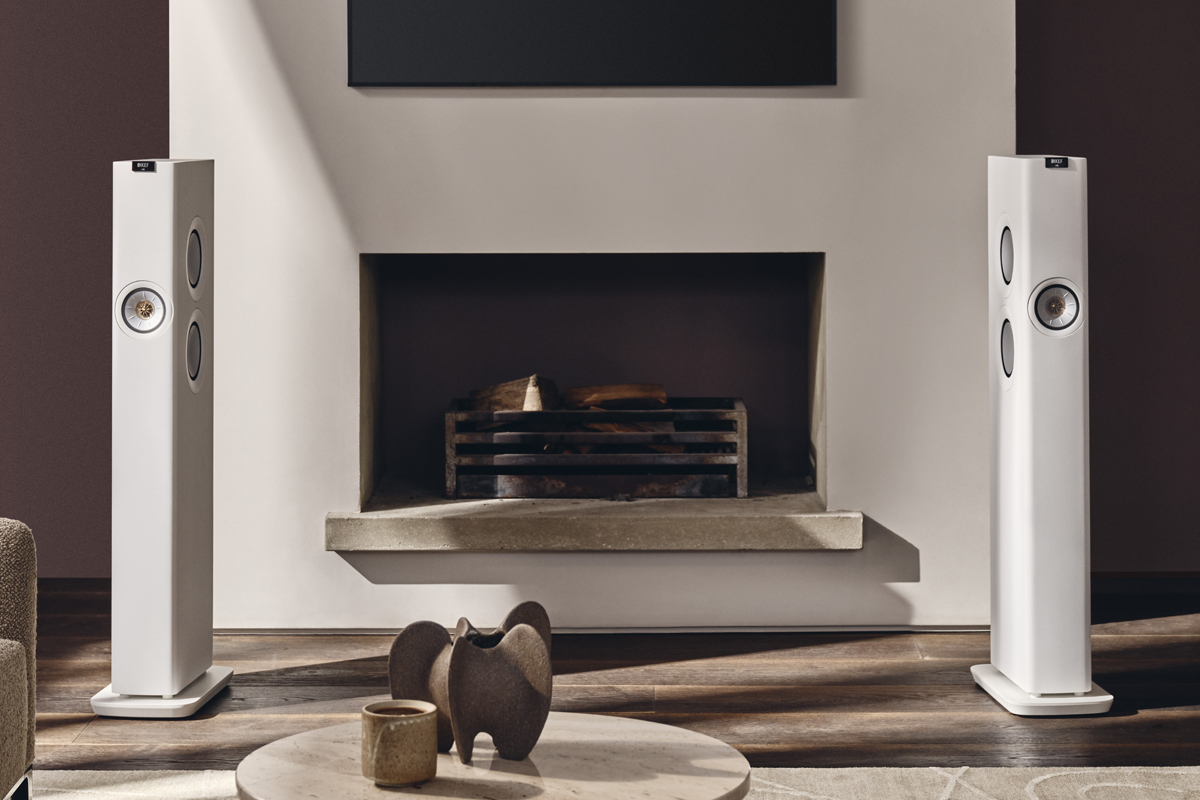 In 2012, to celebrate its 50th anniversary, KEF introduced the LS50 two-way minimonitor ($1499.99/pair at launch, all prices in USD), which went on to become one of the landmark audio products of the 2010s. When he reviewed the LS50 on SoundStage! Hi-Fi in 2013, Doug Schneider concluded: “The LS50 is nothing short of a masterpiece of a minimonitor, priced so that anyone serious about audio can buy a pair.” The LS50 later won a 2013 SoundStage! Network Product of the Year award. Four years later, KEF launched an active speaker employing the same Uni-Q driver array as its passive cousin. The LS50 Wireless ($2499.99/system at launch) was named a SoundStage! Network Product of the Year for 2017.
In 2012, to celebrate its 50th anniversary, KEF introduced the LS50 two-way minimonitor ($1499.99/pair at launch, all prices in USD), which went on to become one of the landmark audio products of the 2010s. When he reviewed the LS50 on SoundStage! Hi-Fi in 2013, Doug Schneider concluded: “The LS50 is nothing short of a masterpiece of a minimonitor, priced so that anyone serious about audio can buy a pair.” The LS50 later won a 2013 SoundStage! Network Product of the Year award. Four years later, KEF launched an active speaker employing the same Uni-Q driver array as its passive cousin. The LS50 Wireless ($2499.99/system at launch) was named a SoundStage! Network Product of the Year for 2017.
More honors followed. The second-generation LS50 Meta ($1599.99/pair) was named a SoundStage! Network Product of the Year in 2020. An active version of that speaker, the LS50 Wireless II ($2799.99/system), received SoundStage! Network POTY honors in 2021. This raises a question: should the LS50 family be considered the Product of the Decade for the 2010s?
On May 12, 2022, KEF announced a new pair of speakers to mark the company’s 60th anniversary. But KEF is celebrating its diamond jubilee with a floorstander instead of a minimonitor. And rather than starting with a passive speaker and introducing an active version later, the LS60 Wireless ($6999.99/system) was conceived as an active design from the get-go. The three amplifiers inside each LS60 enclosure have a combined output of 700W.
KEF says it could not have met the design brief for the LS60 using passive technology. In the white paper for the LS60 Wireless, KEF states: “The goal . . . was to create a compact, slim product with a small footprint . . . [that did not require] users to make significant concessions to the layout of their rooms. This aim creates a sizable acoustic engineering challenge, especially because the internal volume of the loudspeaker will be limited. With a passive configuration the resulting performance would be very limited.”
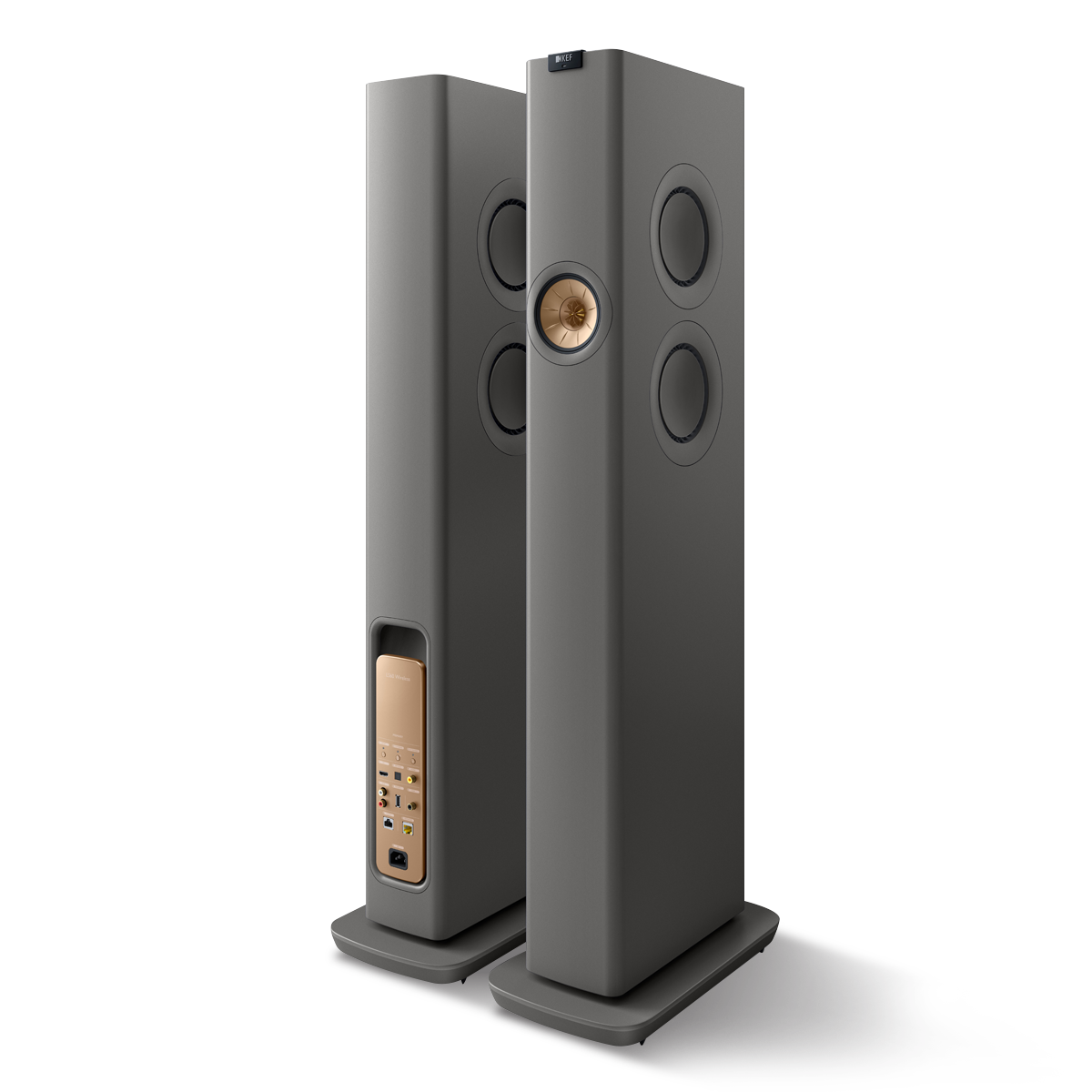
The LS60 Wireless is a fully self-contained music system. Plug each speaker into a wall outlet, connect the system to your home network, and you’re ready to play music. There’s no need to pair the speakers because that’s done at the factory.
The companion KEF Connect app has integrated support for Amazon Music, Deezer, Qobuz, and Tidal. The LS60 supports Apple AirPlay 2 for CD-resolution streaming from any app on a Mac, iPhone, or iPad. Google Chromecast support means you can cue up music in any Cast-enabled app and transfer playback to the LS60, at up to 24-bit/96kHz resolution. The system also supports Spotify Connect and Tidal Connect, so you can select music in the apps for those services and transfer playback to the LS60. It supports UPnP/DLNA, so you can stream music to the LS60 from any app that uses the protocol, such as Audirvana on a PC or Mac or mConnect on an Android device, or pull music from a UPnP-enabled network drive.
KEF says the LS60 is Roon Ready, but the product had not yet received certification from Roon during my testing. However, the LS60 uses the W2 network platform from KEF’s LS50 Wireless II, which is Roon Ready. So Roon certification for the LS60 Wireless should be a mere formality. KEF expects that the LS60 will receive Roon Ready certification by this fall.
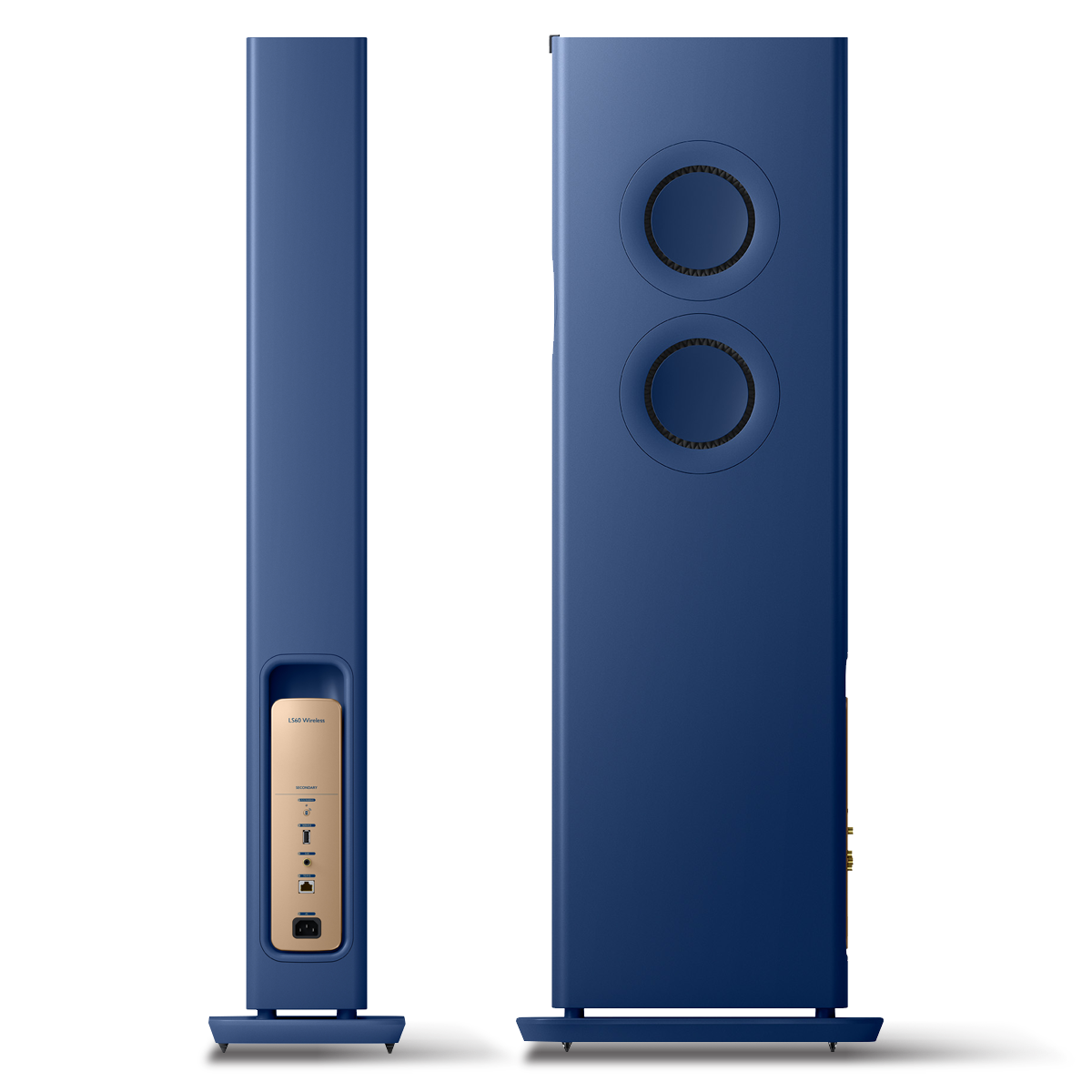
You can also connect external sources to the LS60. The primary speaker has line-level analog connectors, an HDMI eARC port, and optical and coaxial S/PDIF inputs.
Outside . . .
KEF sells the LS60 Wireless as a system comprising a primary and secondary speaker. By default, the primary speaker plays the right channel and the secondary speaker plays the left, but channel designation can be changed in the KEF Connect app’s Settings menu.
Per the design brief, the LS60 Wireless does indeed have a small visual footprint—at least from the front. Each speaker’s front baffle, which houses a Uni-Q driver array comprising a 4″ aluminum-cone midrange unit with a concentrically mounted 0.75″ aluminum-dome tweeter, is a hair more than 5″ wide. Viewed from the side, the LS60 Wireless stands out more, as each speaker has four side-firing 5.25″ woofers—two on each side. The side baffles are nearly 13″ deep.
The LS60 Wireless is available in three painted finishes: Royal Blue, Mineral White, or Titanium Grey. The midrange cones on the Royal Blue and Titanium Grey versions are a pale-gold color; the woofer cones are the same color as the enclosures. The Mineral White version has silver midrange and woofer cones.
Each speaker sits on a plinth that’s wider and deeper than the columnar enclosure. Including the plinth, each cabinet measures 43″H × 8″W × 15.5″D. The plinth has rubber feet, but KEF also includes floor spikes for placing the LS60 speakers on carpeted floors.
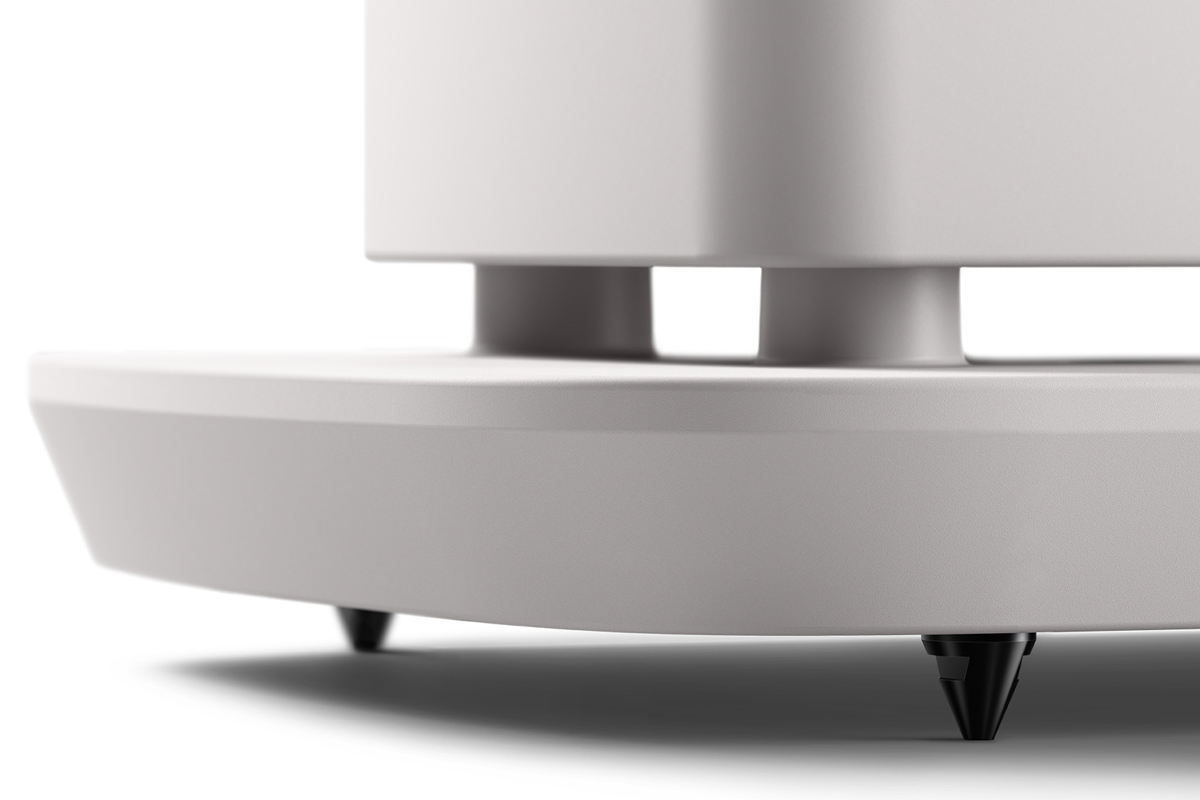
The columnar, monochrome cabinet, narrow front baffle and deep side baffles, and built-in plinth give the LS60 Wireless a modern, monolithic look. At first, I found the styling a bit stark, but the design grew on me, and I ended up liking the look a lot. Something that shifted my opinion was the quality of the finish. My review sample had the Titanium Grey finish, and the pearlescent paint subtly picked up a sage green tint from the wallpaper on my front wall, so the speakers blended nicely into the room.
At the bottom of the primary speaker’s back is an electronics panel, and at the bottom of that panel are a three-prong IEC power inlet and two ethernet ports. The port on the right can be used for hardwiring the primary speaker to your network router or an access point; but the LS60 Wireless also has built-in Wi-Fi. The port on the left, marked “To P/S,” can be used for sending digital audio to the secondary speaker. But the primary speaker can also send digital audio to the secondary speaker wirelessly, using a walled-garden version of WiSA technology.
Above the two ethernet ports on the primary speaker are a pair of RCA line-level analog inputs, a USB Type-A port for service, and an RCA output jack for a subwoofer. The secondary speaker also has a sub output. You can enable low-pass filters for the sub(s) and high-pass filters for the mains in the EQ Settings menu of the KEF Connect app.
Higher up still are an HDMI eARC port and optical (TosLink) and coaxial (RCA) S/PDIF ports. Maximum resolution is 24/192 via HDMI and coaxial S/PDIF, and 24/96 via optical S/PDIF. For networked sources via ethernet or Wi-Fi, maximum resolutions are 24/384 and DSD128. All sources are resampled to 24/96 PCM with a wireless connection between the two speakers or 24/192 PCM with a wired connection. The LS60 has MQA decoding and rendering capability for playing Masters content from Tidal, as well as MQA-encoded CDs and downloads.
On the top of the primary speaker’s rear panel are three buttons: one for resetting the system, one for wireless pairing of the primary and secondary speakers if required, and one for Bluetooth pairing.
From top to bottom on the rear panel of the secondary speaker are a wireless pairing button, a USB service port, the subwoofer output jack, an ethernet port for wired connection to the primary speaker, and a three-prong IEC power inlet.
Both speakers have LED indicators at the top of their front panels. The LED on the secondary speaker illuminates briefly when the speaker is first connected to a power output, and lights up when an error occurs. On the primary speaker, the LED glows and flashes different colors to indicate the selected input and network status.
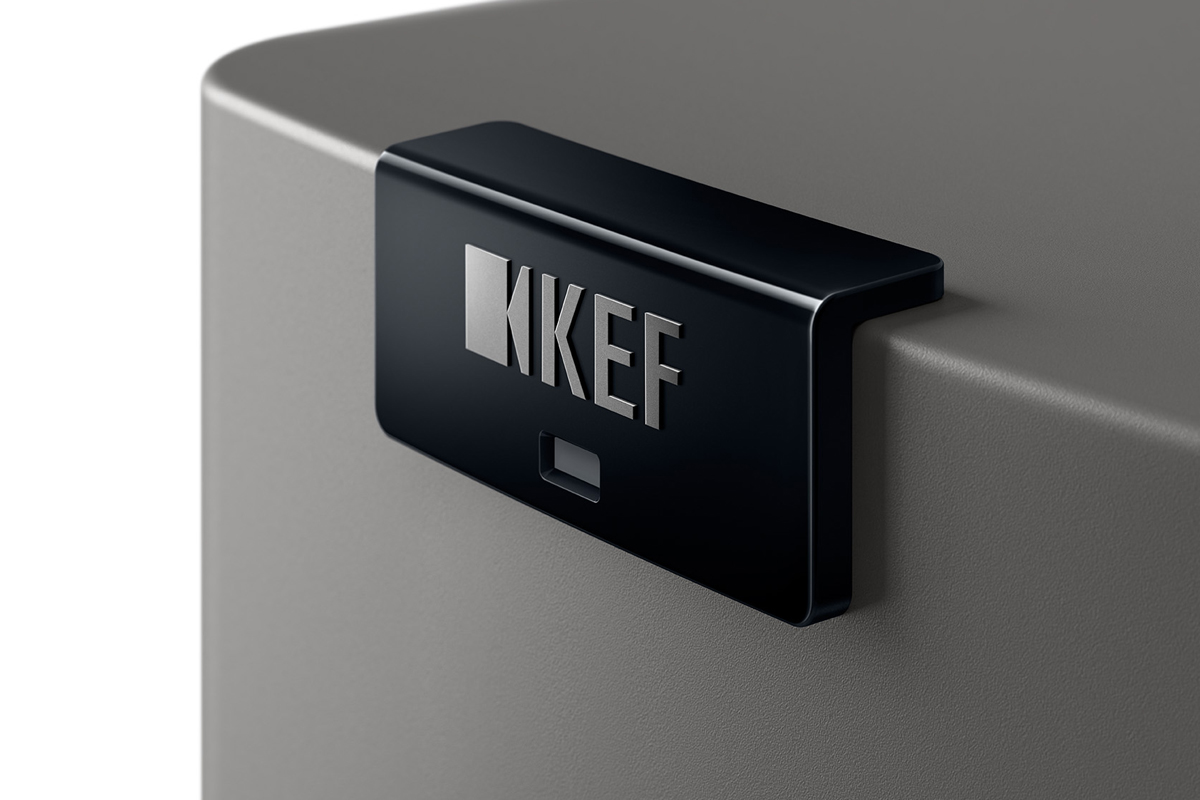
The LS60 Wireless system includes a small remote control with buttons for adjusting volume, muting the speakers, powering them on and off, cycling through sources, pausing and resuming playback, and skipping tracks. You can also perform all these functions with the KEF Connect app.
. . . and Inside
The LS60 Wireless incorporates a lot of groundbreaking technology. For a deep dive, it’s worth checking out KEF’s LS60 Wireless white paper. What follows is a CliffsNotes version.
The LS60’s 12th-generation Uni-Q driver array features KEF’s Metamaterial Absorption Technology, which made its debut on the LS50 Meta. A labyrinthine disc behind the driver absorbs rearward energy from 840Hz upward, preventing it from being reflected by the enclosure’s interior surfaces and interfering with frontward radiation.
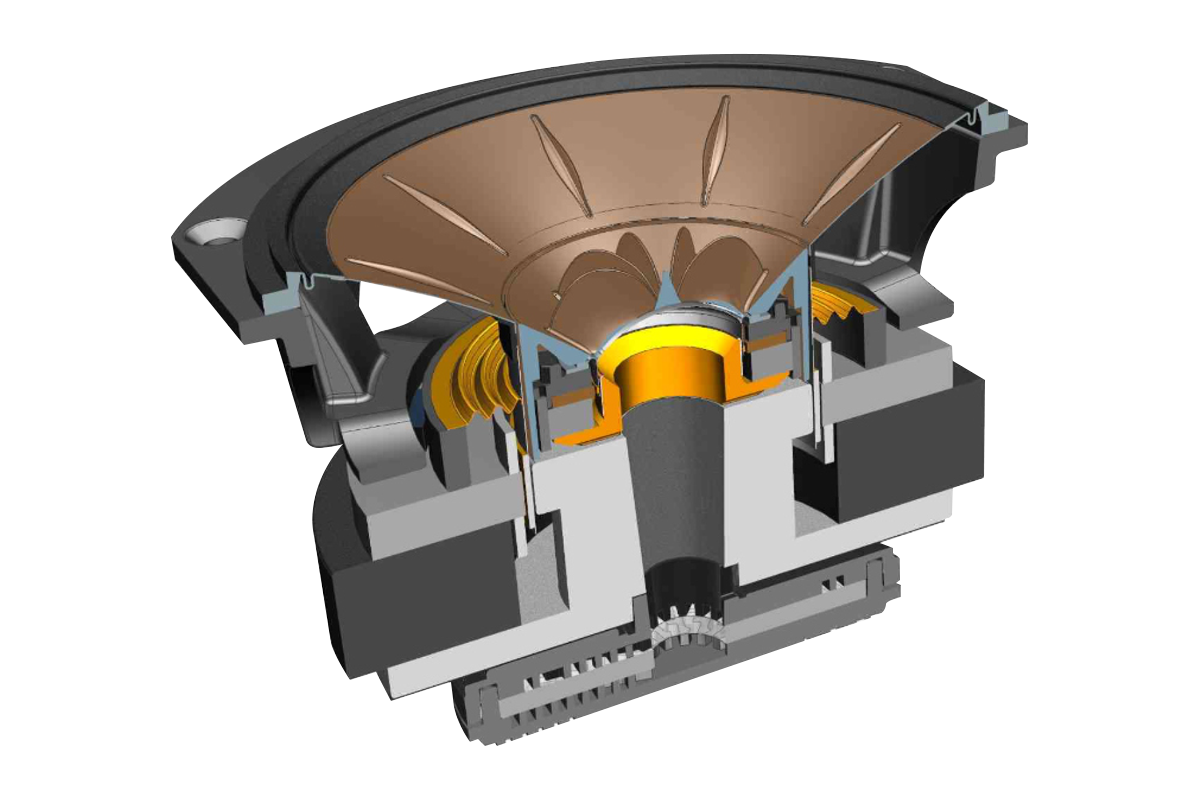
The 4″ midrange driver and 0.75″ tweeter on the LS60’s Uni-Q array are smaller than the drivers on the similar units employed on other KEF loudspeakers, such as the LS50 Meta and LS50 Wireless II. To allow high output capability from the smaller drivers, KEF redesigned the surround and suspension to maximize excursion.
Low frequencies from each speaker are produced by two Uni-Core woofer arrays, each comprising two 5.25″ drivers mounted on opposite sides of the enclosure in a back-to-back, force-canceling configuration. Reactive forces from the motion of the cones cancel each other out, so that energy is not transferred to the enclosure.
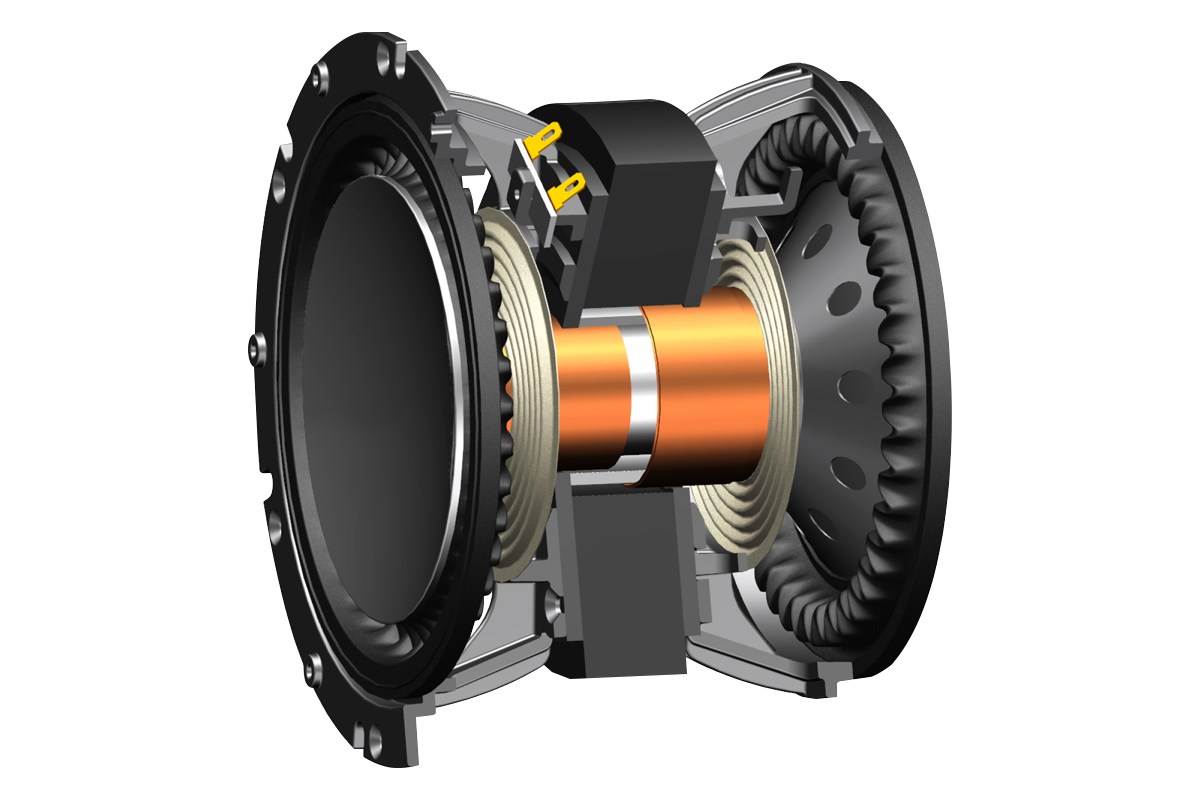
To allow for the slim enclosure, the two woofers in each Uni-Core array share a single motor structure, with overlapping voice coils of different diameters. This groundbreaking technology made its debut on KEF’s KC62 subwoofer ($1499.99), another SoundStage! Network Product of the Year. But it was actually developed for the LS60.
The woofers’ pleated P-Flex surrounds are designed to withstand the pressures that build up inside the sealed 12.5-liter enclosure without buckling.
Like in KEF’s flagship passive floorstanders—the Blade One Meta ($34,999.98/pair) and Blade Two Meta ($27,999.98/pair)—the acoustic centers of the Uni-Core woofer arrays and Uni-Q driver array are almost coincident. According to the white paper, this Single Apparent Source configuration creates “a virtual source of sound that comes from one position in space over the entire loudspeaker bandwidth.”
The LS60 also features the company’s Smart Distortion Control Technology: a system that compares measured cone motion with stored driver parameters, then uses DSP to apply a correcting signal. The LS60 also applies dynamic EQ, allowing bass extension to 26Hz at normal listening levels, but reducing bass output and extension at very high levels to prevent damage to the drivers. This adaptive control would of course not be possible with a passive design.
Another advantage of the active design is the ability to use amplifiers designed specifically for the system’s drivers, and the frequency range these drivers cover. As KEF explains in the white paper, reproducing low-frequency sounds requires an amplifier that can deliver ample power on a continuous basis. Reproducing high frequencies requires only low levels of continuous amplifier power; but high levels of instantaneous peak power are needed to reproduce sudden transients. With some demanding content, high levels of continuous power may be required to reproduce midrange sounds convincingly.
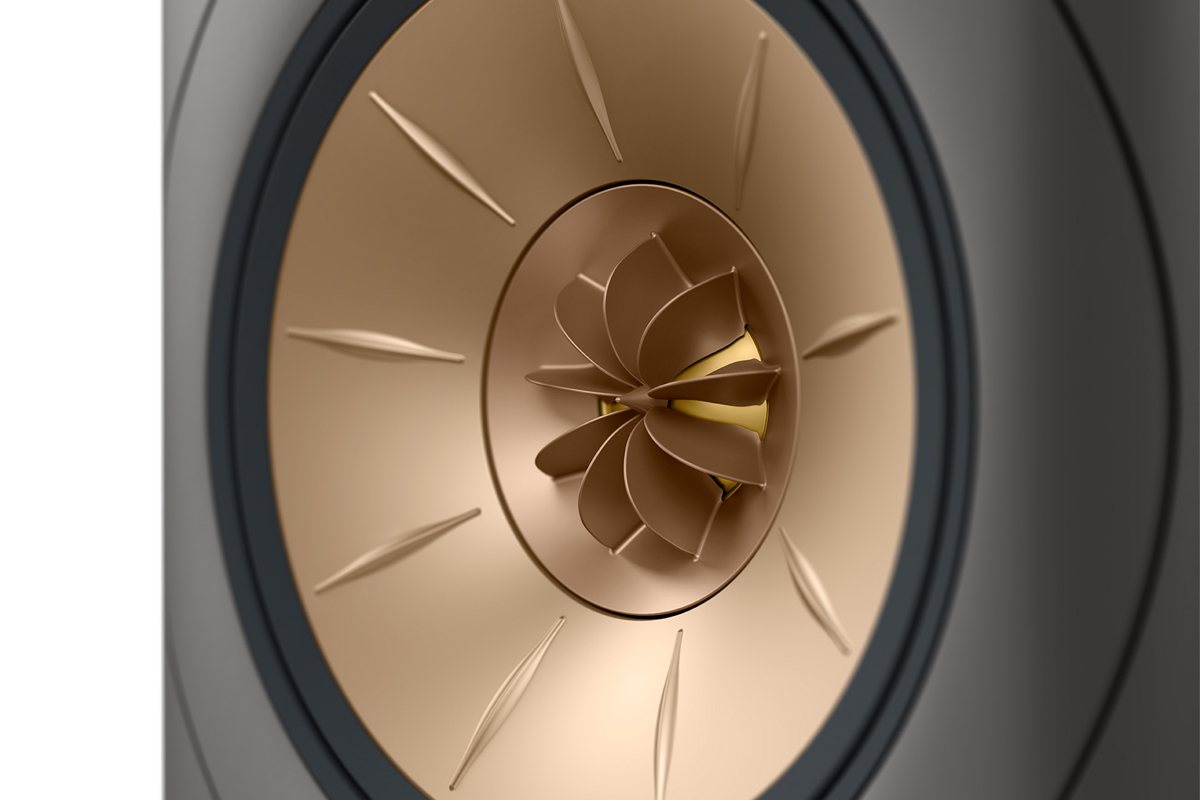
To meet these requirements, each speaker uses a 500W class-D amplifier to power its four woofers, a 100W class-D amp for the midrange driver, and a 100W class-AB amp for the tweeter. The efficiency of the class-D amplifiers means they can deliver a lot of continuous power with very little heat buildup—a vital consideration for amplifiers installed in a relatively small enclosure. The tweeter requires only low continuous output, so heat buildup isn’t a problem—hence the use of a class-AB design for the high-frequency section. This allows for wider bandwidth, as the class-AB amp does not require an output filter.
Setup and software
I never comment on the packaging of the products I review, but I have to make an exception here. The LS60 Wireless ships in two tall cartons, each package weighing about 85 pounds. The driver who delivered my review sample helped me get the speakers onto my front porch. But how would I get them out of their cartons and into their listening positions?
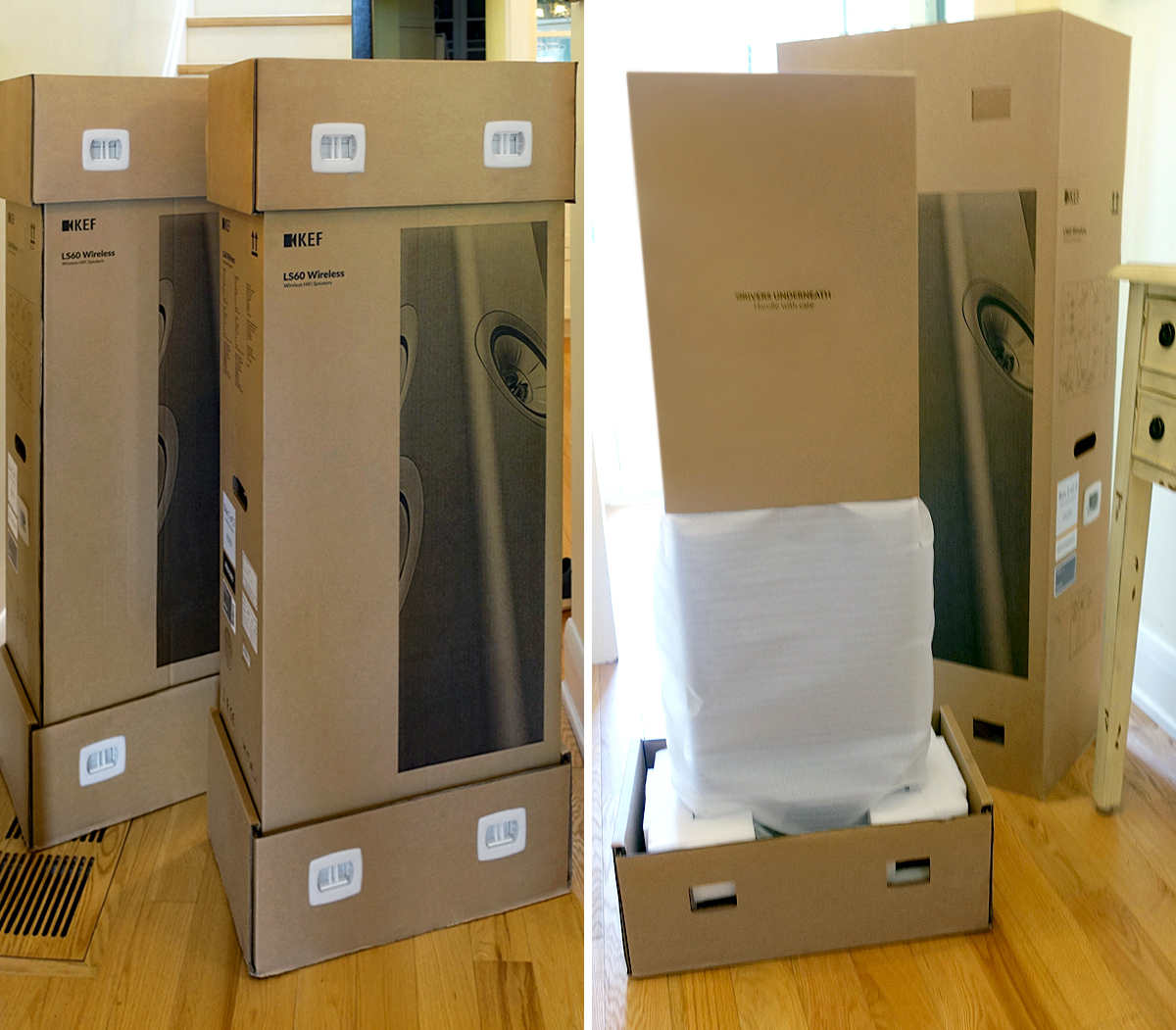
I needn’t have worried, because the LS60 has the cleverest packaging I’ve ever seen on an audio product. The outer packaging consists of heavy-cardboard top and bottom caps fastened to a foldable cardboard sleeve. Remove the plastic inserts holding the caps to the sleeve, then lift off the top cap and remove the cardboard sleeve. The outer edges of the bottom caps fold down, so that you can slide the speakers out and into position. There are caps on the tops of the speakers to protect them as you slide them into place. Genius!
By contrast, the Quick Start Guide packaged with the primary speaker is as perfunctory as it gets: just a couple of diagrams that direct you to connect the speakers to a wall outlet and watch for a flashing amber LED on the primary, followed by an instruction to download the KEF Connect app from Google Play or Apple’s App Store. Fortunately, KEF’s 108-page downloadable manual is a model of completeness and clarity.
When you launch KEF Connect, the app will prompt you to set up an account with KEF. The next step is getting the LS60 on your home network. With a wired connection, that happens automatically. The process for connecting the LS60 to a Wi-Fi network is different for iOS and Android: the app directs you to the AirPlay Accessory Setup menu on iOS devices, and to the Google Home app on Android. Piece of cake, either way.
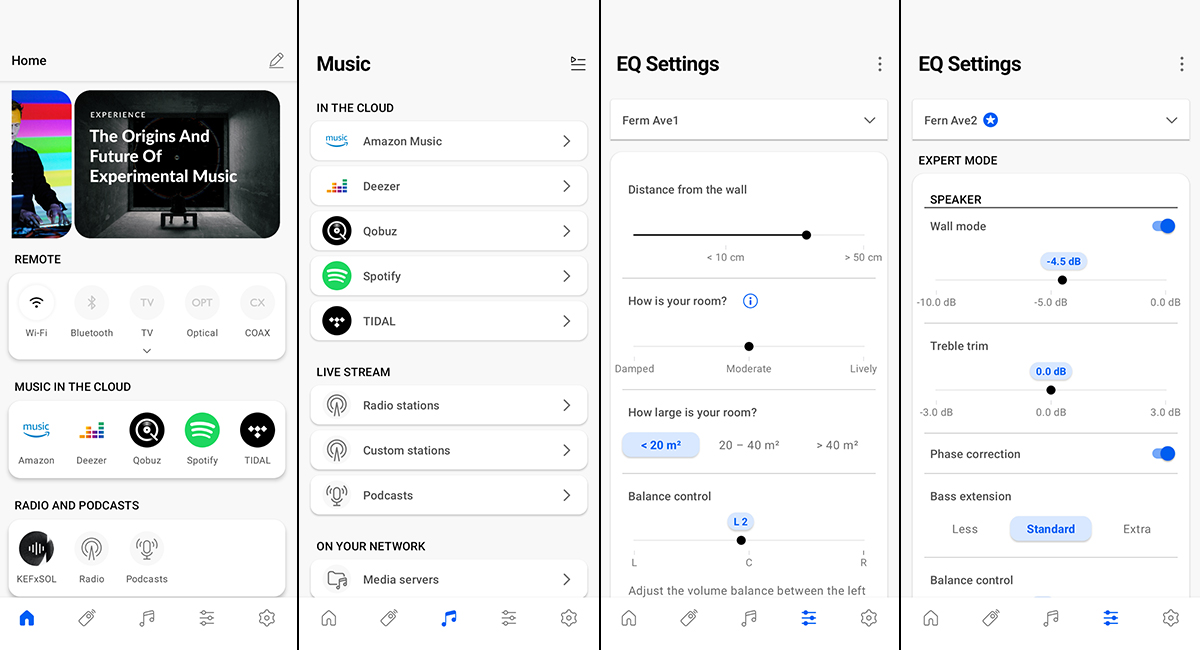
With the KEF Connect app, you can cue up music in any of the supported streaming services, change the channel designation of your speakers, check for firmware updates, and confirm network quality. A worthwhile feature is the ability to create a custom speaker profile for your room in the EQ settings menu. There are two options: In Normal mode, you specify the distance between the speakers and front wall, and the acoustic character of your listening room (Damped, Moderate, Lively). The app will make EQ adjustments based on your settings. In Expert mode, you specify how much you want to cut bass output to compensate for room placement and how you want to adjust treble to compensate for room acoustics. I created two profiles: one in Normal mode and one in Expert mode. In the former, which I used for most of my listening, I moved the slider that specifies the distance from the wall to 40cm and chose a moderately damped room under 20m2 in area. In the Expert mode, I activated Wall mode and moved the LF slider control to -4dB.
I found KEF Connect functional and easy to navigate. There was just one bit of weirdness. Sometimes when I switched from one track to another in a Qobuz playlist, the Now Playing screen would show the track I’d jumped from, and there was no way to fix this other than restarting the app.
Throughout my testing, Wi-Fi and inter-speaker communications both worked flawlessly—I experienced nary a hiccup. During my testing, I streamed music to the LS60 from Amazon Music and Qobuz using the KEF Connect app. I also streamed via AirPlay from my iPhone 8, by Chromecast from my Google Pixel smartphone, and over UPnP from the Audirvana app on my HP Spectre 360 notebook PC—all without issue.
Listening
I placed the LS60 Wireless speakers on either side of the electric fireplace in my living room. They were 7′ apart and 7′ from my listening position on the end cushion of the sectional sofa on the opposite wall. The back panels of the speakers were 15″ from the wall behind them. After a little experimentation, I ended up with the speakers toed in about 10°. For movie and TV playback, I connected the HDMI ARC port of the One Connect breakout box for my Samsung Frame TV to the HDMI eARC port on the primary speaker.
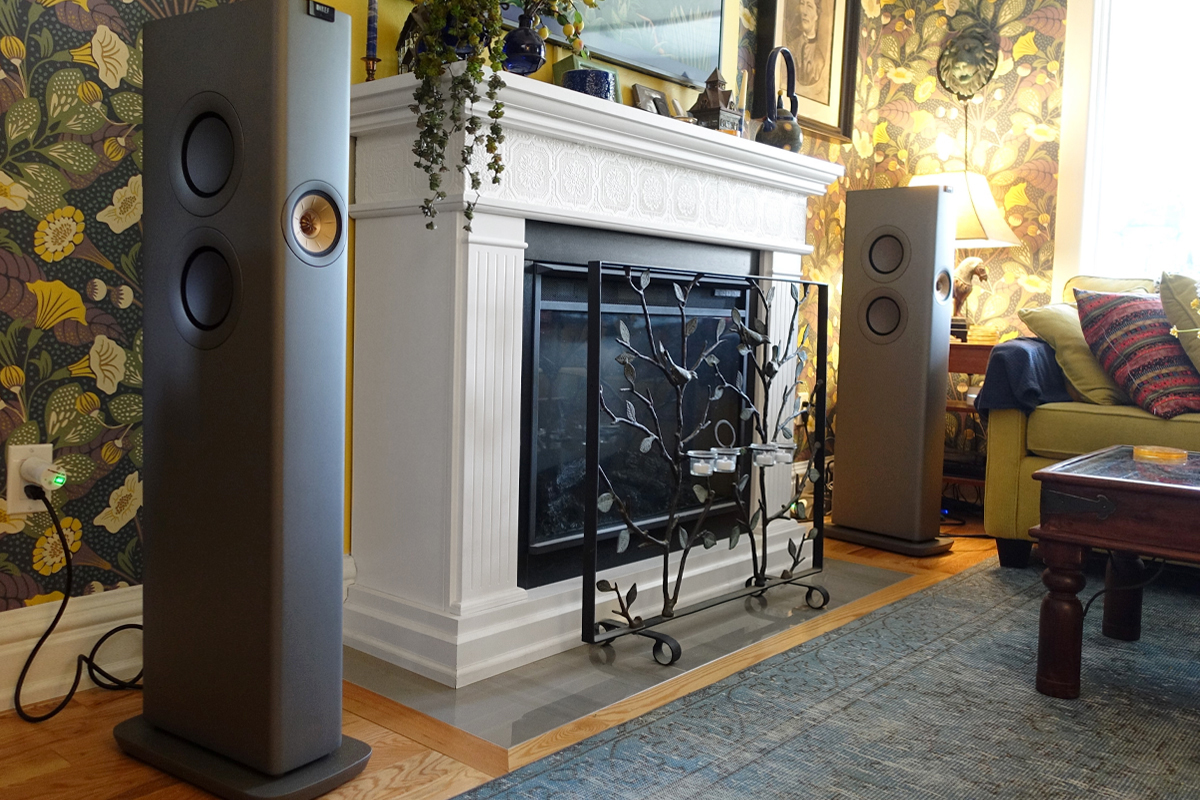
I enjoyed the KS60 Wireless speakers from the very first tune I played through them. But the more I listened, the more I loved the system. Here are some of the virtues the LS60 revealed during my listening:
- The sound was coherent and seamless throughout the audioband. I was never aware of different drivers covering different frequencies. The speakers had wonderful fluidity and ease of delivery—music just happened.
- Soundstaging and imaging were excellent. The LS60 generated aural images that were completely divorced from the speakers.
- Bass was deep, powerful, and well controlled, with excellent pitch differentiation. According to KEF, the -6dB point of the LS60 can be as low as 26Hz, depending on the EQ setting; frequency response is 31Hz–24kHz. Based on my listening, I find these claims completely believable. Granted, I did hear some room boom, but that has nothing to do with the LS60 system. As I’ve noted in past reviews, my listening room has some nasty standing waves. But the EQ settings I made in the KEF Connect app went a long way toward taming that problem.
- Male and female vocals were spot-on; not just timbrally accurate, but three-dimensional and embodied. It was like the singers were in the room with me.
- Dynamics were outstanding. Transients were fast, not because highs were exaggerated, but because the drivers and amps responded instantaneously to musical peaks. Transients segued naturally into sustains and decays, combining to form integrated musical events.
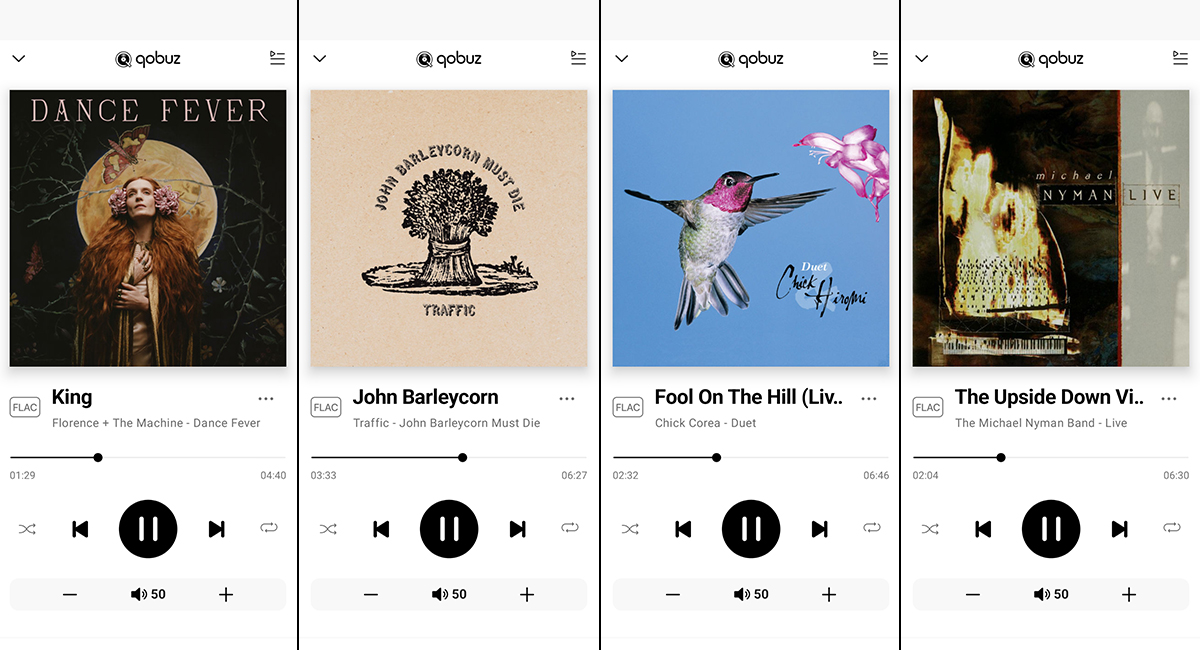
Played through the LS60 Wireless, “King,” the anthemic opening track to Dance Fever by Florence and the Machine (24-bit/96kHz FLAC, Polydor Records / Qobuz), the soundstage filled the entire front half of my living room, extending above the plane described by the top edges of the speakers, far beyond their outer edges, and behind the front wall of my room. These svelte floorstanders nailed the pounding electric-bass notes and kickdrum beats that underpin the song—they were big, bold, and effortless. I could feel those notes in my legs and torso, but they were taut and well defined. Equally enthralling was the way the LS60 delivered instrumental phrases in the interlude near the end of the track and the final verse, both in the big wall-of-sound section and in quieter bits that followed. The Mellotron notes swirled powerfully around the whole soundstage, while the acoustic guitar chords emerged in the center rear, with the piano and harp phrases to the left and right. I could clearly hear the action of fingernails against the guitar’s nylon strings, and the woody resonance that followed. Transients of the high-pitched harp notes were fast but not exaggerated. All these details sounded completely organic—part of a complete performance.
Florence Welsh’s voice was locked in place in the center of the soundstage, just above the speaker plane, fully embodied and three-dimensional. In the choruses, the LS60 system delivered her soaring vocals effortlessly; but what really got to me was the speakers’ ability to track sudden dynamic shifts. Welsh’s accented phrases at the beginning of each line were delivered effortlessly. Every word, every phrase was completely intelligible, yet consonants were not the least bit hot.
The LS60 system was just as satisfying with male voices, as I confirmed by playing the title track from Traffic’s John Barleycorn Must Die (24/96 FLAC, Island Records / Qobuz). Steve Winwood’s reedy tenor was locked in the center of the soundstage, sounding full and embodied, and nicely separated from Jim Capaldi’s deeper voice, harmonizing just a little to the right. Just below Winwood’s voice was his steel-strung acoustic guitar, just where it would have been in a live performance. The timbre was perfect, with the sound of Winwood’s picking and strumming quickly followed by the resonance of the guitar’s soundbox. The spatial presentation was superb, with Chris Wood’s flute phrases appearing on the right side of the soundstage, and his taps on the wood block and triangle on the left, as if by magic.
I was gobsmacked by the way these compact floorstanders rendered a performance of The Beatles’ “Fool on the Hill” by jazz pianists Chick Corea and Hiromi Uehara from their live album, Duet (16/44.1 FLAC, Concord Jazz / Qobuz), recorded at Tokyo’s Blue Note Jazz Club in 2007. Twenty seconds in, Corea plays a repeated percussive note in the bottom octave with his right hand, while he uses his left hand to mute the strings inside the instrument. These notes sounded big and powerful—the KEF nailed the drum-like effect that Corea clearly intended. Hiromi’s playful runs in the middle and upper octaves were beautifully articulate, and not at all clangy. The tonality of the two Yamaha concert grand pianos was perfect—consistent from top to bottom, with tons of heft down low, and wonderful impact and clarity in the middle and upper octaves. Throughout the piece, the KEF system delivered a perfect balance of touch and tonality, highlighting Corea’s lyrical style and Hiromi’s playfulness. And again, the soundstage was vast—completely filled-in and three-dimensional. Dynamics were hugely impressive—the KEF conveyed the massive power of the two instruments with clarity.
I can’t think of a contemporary composer who communicates unbridled joy as effectively as Michael Nyman. This quality is on full display in a 1994 live performance of “The Upside-Down Violin” on Live (16/44.1 FLAC, Venture Records / Qobuz) by the combined forces of the Michael Nyman Band and the Moroccan Orquesta Andaluzi de Tétuoan.
Toward the end of the first movement, Slow, a few of the Moroccan players take turns playing solos, accompanied by the insistent beat of a goblet drum in the rear of the soundstage. The high-pitched sounds of fingertips beating on the edge of the goblet drum were ideally crisp, and segued beautifully into short-lived resonances in the drum’s skin and body. On the right side, the plucked strings of the qanun (a tabletop string instrument, a bit like a large zither) had gorgeous clarity. Again, the initial plucks segued naturally into the short-lived resonance of the soundbox, adding harmonic richness. The LS60 also nailed the exotic slides and distinct nasal timbre of the solo violin on the left front, played gamba-style with the saddle nestled in the player’s lap (hence the name of the suite). In the left rear, plucks on the laúd (a lute-like string instrument) were fast and crisp, followed by rich, woody resonance.
All these instruments were presented on a wide, deep soundstage with holographic precision. During these passages, I could hear the goblet drum and solo instruments reverberating through the Spanish concert hall, which created a real sense of occasion.
The third movement, Faster Still, is a wild romp, and here the LS60 showed its dynamic chops, delivering this six-and-a-half-minute wall of sound with consummate ease. Even as the piece exploded into my living room, it was easy to pick out expressive details: the violinists’ insistent bowing, the frenetic strumming on the laúd and qanun, the shrill phrases of the piccolo, the wild beats of the goblet drum—they all sounded glorious. At no point did the LS60 sound strained or congested, and there was never a sign of dynamic compression.
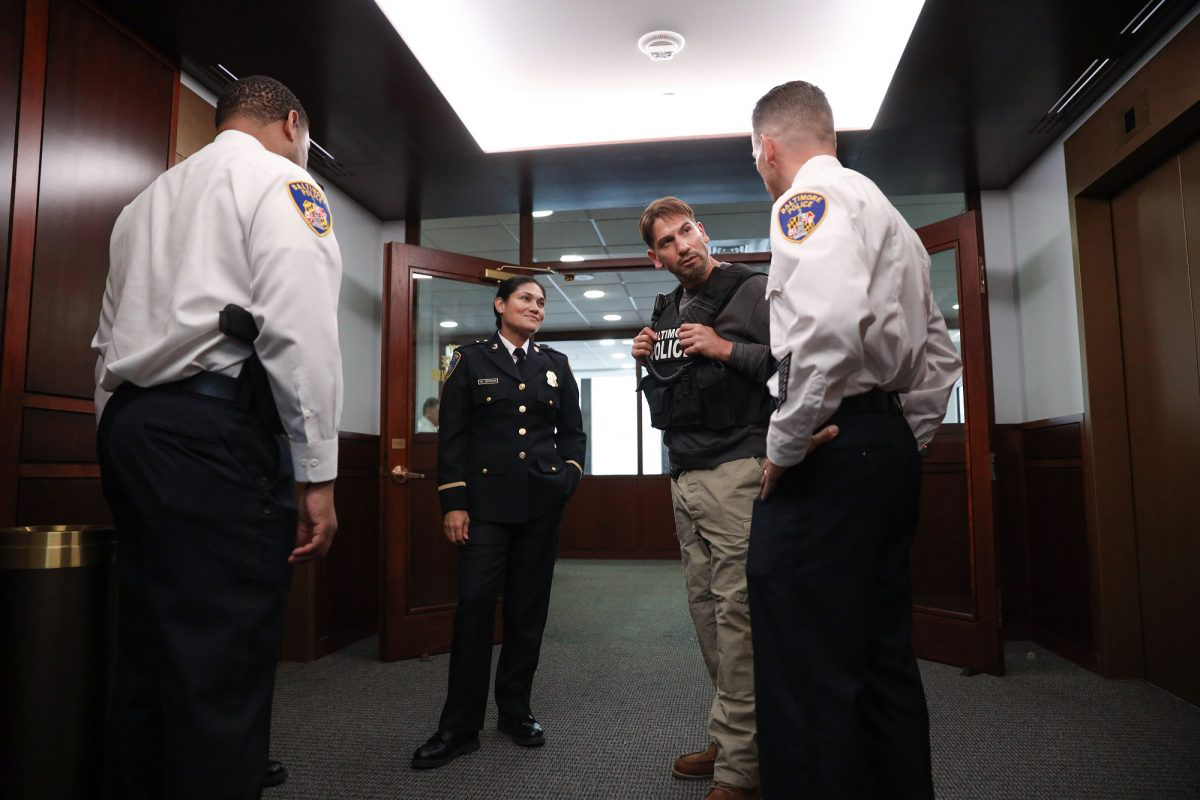
The LS60 Wireless proved just as satisfying with movies and TV, as I confirmed when I binged We Own This City, George Pelecanos and David Simon’s six-part HBO series about police corruption in Baltimore. The opening theme music sounded fantastic. The big hip-hop drumbeats were explosive yet well controlled, the synth notes deep and powerful, and the wailing trumpet ironically mournful. The gunshots and urban sounds that accompany the theme music were just as impressive. So too were effects during the show itself. The sounds of chaos and chanting crowds during the depiction of the Freddie Gray protests filled my living room. Dialog was consistently clear and easy to follow. The presentation wasn’t as immersive as it would have been with a full-blown surround system; but it was big and effortless.
Comparison
I compared the LS60 with my reference setup: an NAD C 658 streaming DAC-preamp ($1999.99) connected with Benchmark Media Systems Studio&Stage XLR interconnects to a pair of Elac Navis ARF-51 active floorstanding speakers ($5399.96/pair). The ARF-51 is a three-way active floorstanding speaker, with three 5.25″ woofers and a coaxial driver comprising a 4″ midrange and 1″ soft-dome tweeter.
One of the C 658’s standout features is Dirac Live room correction, but to keep this comparison as even as possible, I disabled that feature. However, I did set the low-frequency EQ switches on the backs of the Elac speakers to -4dB, the same setting I applied to the LS60 using Expert mode in KEF Connect’s EQ Settings menu. I matched the levels of the two systems to within 0.5dB with a sound pressure meter and a pink noise test tone.
On “King” by Florence and the Machine, Welsh’s voice had a slightly papery edge through the Elacs—especially noticeable with her breathing—but this wasn’t the case with the LS60 system. Loud sibilants were a little hotter through the Elacs, and the bass guitar and kickdrum didn’t hit quite as hard. During the wall-of-sound passages, the sound was more compressed and a little harsher with the Elacs. Everything was a little more mushed-together. Harp transients were sharper, but I heard less of the woody resonance of the acoustic guitar. The soundstage was comparably high and deep with the NAD/Elac setup, but did not extend as far to the sides as it had with the LS60 system. Imaging specificity was similar, but the soundstage seemed more filled-in with the KEF setup—aural images had greater three-dimensionality.
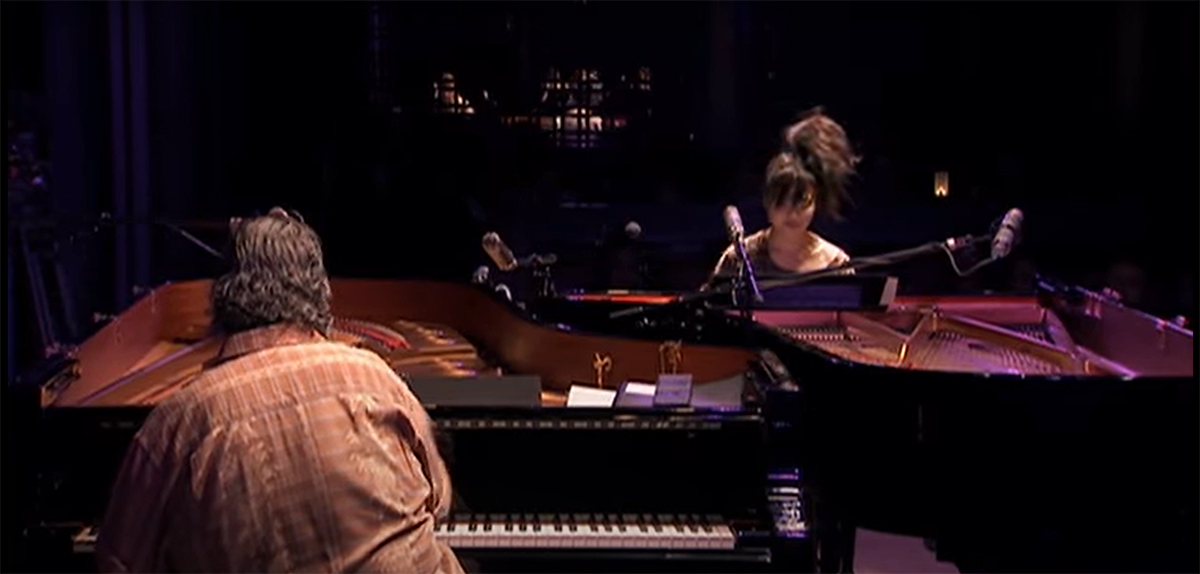
Playing Corea and Hiromi’s rendition of “Fool on the Hill,” the two pianos had less heft down low through the Elacs, but more ringing clarity in the middle and upper octaves. At first it seemed as if this made the phrasing of the pianists more articulate, but careful listening proved that the KEF was rendering the phrasing just as clearly. But through the LS60 system, the instruments sounded bigger and more authoritative—more like concert grands playing in a live performance space. Piano tone was clangier on the Elacs, fuller and more powerful on the KEF speakers; dynamics were a tad compressed on the Elacs compared to the KEF system. And the soundstage created by the KEF system was wider and more filled-in, more effectively evoking the experience of hearing two supremely talented pianists performing in a legendary venue.
Conclusion
The musical examples I’ve cited are a small part of the listening I did with the LS60 Wireless speaker system. I could mention many more: the astonishing palpability of David King’s floor-tom beats in the opening to “In Stitches” from Made Possible by The Bad Plus, the transparent orchestral textures in François-Xavier Roth’s recording with Les Siècles of Debussy’s Prélude àl’après-midi d’un faune—these were all revelatory listening experiences. On album after album, I found myself thinking, “This sounds so right.” Everything—timbre, dynamics, spatial presentation—seemed so natural and effortless. Nothing got in the way of the music.
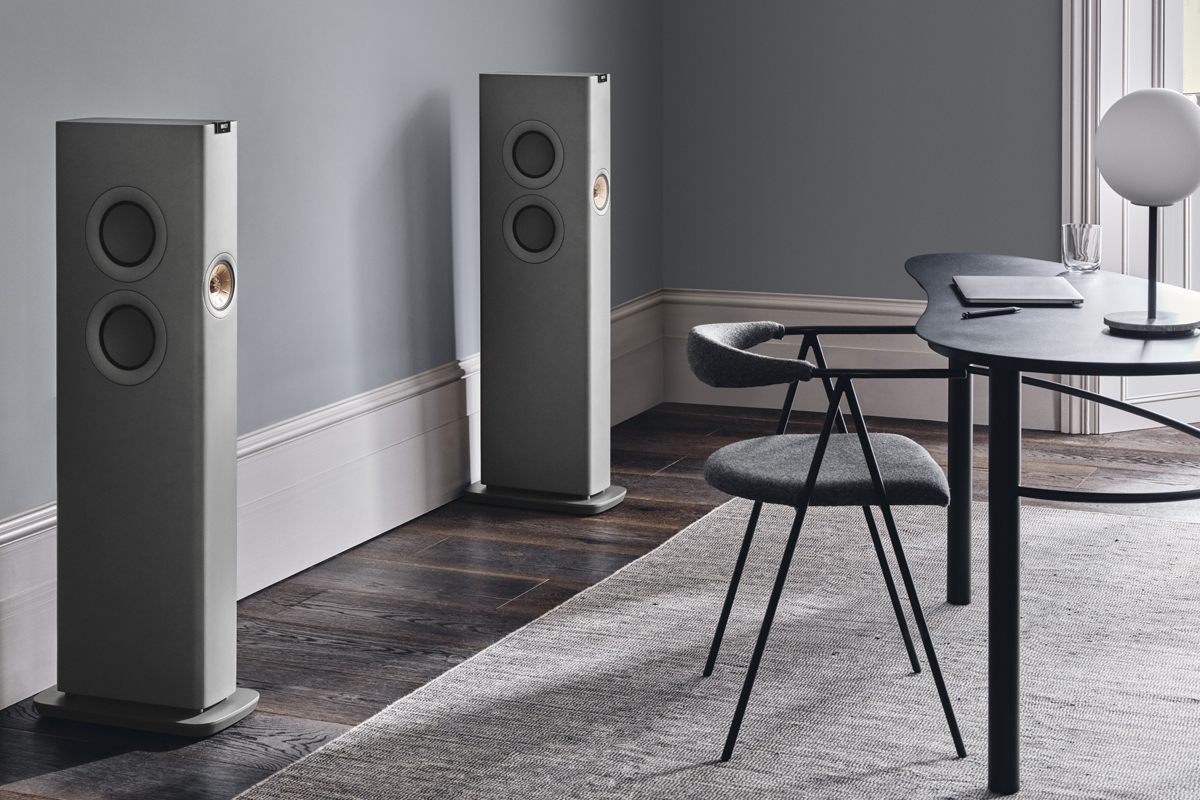
While the LS60 system could not fully convey the power and scale of a live concert (how could it?), it could certainly evoke that experience. Closing my eyes and listening, I could easily imagine that I was sitting at a table at the Blue Note in Tokyo listening to Corea and Hiromi, or in a Spanish auditorium hearing the Michael Nyman Band and the traditional instruments of the Moroccan musicians. This system is truly transporting.
So will history repeat itself? Will the LS60 Wireless speaker system be named a SoundStage! Network Product of the Year, as the LS50 minimonitor was a decade ago? That’s not for me to say—these awards are a group decision. But the LS60 system is a landmark product, just as the LS50 and its progeny were. Who knows: ten years hence, might we think of the LS60 Wireless as audio’s Product of the Decade for the 2020s?
. . . Gordon Brockhouse
Associated Equipment
- Active loudspeakers: Elac Navis ARF-51.
- Streaming DAC-preamp: NAD C 658.
- Sources and control devices: Apple Mac Mini (M1) running Roon Core 1.8, HP Spectre x360 notebook PC running Audirvana 3.5.51, Google Pixel 4a 5G smartphone.
- Display: Samsung UN55LS003 UHD TV “The Frame.”
- Network: Google Wifi four-node mesh network.
KEF LS60 Wireless Active Speaker System
Price: $6999.99/system.
Warranty: Five years, parts and labor; active electronics, two years.
KEF
GP Acoustics (UK) Ltd.
Eccleston Road, Tovil
Maidstone, Kent ME15 6QP
United Kingdom
Phone: +44 (0)1622-672261
Fax: +44 (0)1622-750653
Email:
Website: www.kef.com
North America:
GP Acoustics (US) Ltd.
10 Timber Lane
Marlboro, NJ 07746
United States
Phone: (732) 683-2356
Fax: (732) 683-2358
Email:
Website: www.kef.com/us



